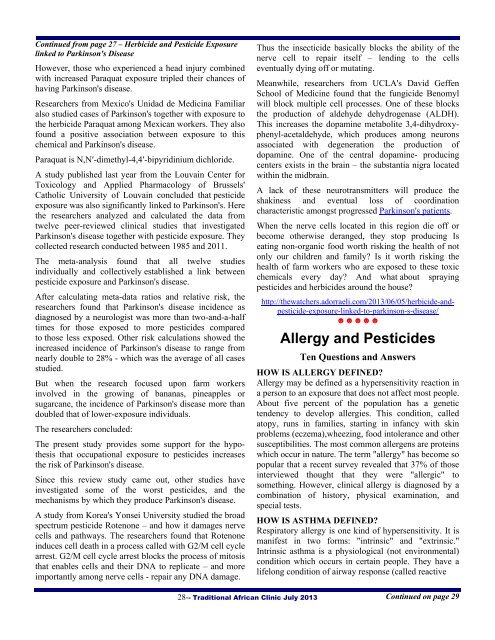toxicity - pesticides, herbicides and insecticides - Blackherbals.com
toxicity - pesticides, herbicides and insecticides - Blackherbals.com
toxicity - pesticides, herbicides and insecticides - Blackherbals.com
Create successful ePaper yourself
Turn your PDF publications into a flip-book with our unique Google optimized e-Paper software.
Continued from page 27 – Herbicide <strong>and</strong> Pesticide Exposurelinked to Parkinson's DiseaseHowever, those who experienced a head injury <strong>com</strong>binedwith increased Paraquat exposure tripled their chances ofhaving Parkinson's disease.Researchers from Mexico's Unidad de Medicina Familiaralso studied cases of Parkinson's together with exposure tothe herbicide Paraquat among Mexican workers. They alsofound a positive association between exposure to thischemical <strong>and</strong> Parkinson's disease.Paraquat is N,N′-dimethyl-4,4′-bipyridinium dichloride.A study published last year from the Louvain Center forToxicology <strong>and</strong> Applied Pharmacology of Brussels'Catholic University of Louvain concluded that pesticideexposure was also significantly linked to Parkinson's. Herethe researchers analyzed <strong>and</strong> calculated the data fromtwelve peer-reviewed clinical studies that investigatedParkinson's disease together with pesticide exposure. Theycollected research conducted between 1985 <strong>and</strong> 2011.The meta-analysis found that all twelve studiesindividually <strong>and</strong> collectively established a link betweenpesticide exposure <strong>and</strong> Parkinson's disease.After calculating meta-data ratios <strong>and</strong> relative risk, theresearchers found that Parkinson's disease incidence asdiagnosed by a neurologist was more than two-<strong>and</strong>-a-halftimes for those exposed to more <strong>pesticides</strong> <strong>com</strong>paredto those less exposed. Other risk calculations showed theincreased incidence of Parkinson's disease to range fromnearly double to 28% - which was the average of all casesstudied.But when the research focused upon farm workersinvolved in the growing of bananas, pineapples orsugarcane, the incidence of Parkinson's disease more th<strong>and</strong>oubled that of lower-exposure individuals.The researchers concluded:The present study provides some support for the hypothesisthat occupational exposure to <strong>pesticides</strong> increasesthe risk of Parkinson's disease.Since this review study came out, other studies haveinvestigated some of the worst <strong>pesticides</strong>, <strong>and</strong> themechanisms by which they produce Parkinson's disease.A study from Korea's Yonsei University studied the broadspectrum pesticide Rotenone – <strong>and</strong> how it damages nervecells <strong>and</strong> pathways. The researchers found that Rotenoneinduces cell death in a process called with G2/M cell cyclearrest. G2/M cell cycle arrest blocks the process of mitosisthat enables cells <strong>and</strong> their DNA to replicate – <strong>and</strong> moreimportantly among nerve cells - repair any DNA damage.Thus the insecticide basically blocks the ability of thenerve cell to repair itself – lending to the cellseventually dying off or mutating.Meanwhile, researchers from UCLA's David GeffenSchool of Medicine found that the fungicide Benomylwill block multiple cell processes. One of these blocksthe production of aldehyde dehydrogenase (ALDH).This increases the dopamine metabolite 3,4-dihydroxyphenyl-acetaldehyde,which produces among neuronsassociated with degeneration the production ofdopamine. One of the central dopamine- producingcenters exists in the brain – the substantia nigra locatedwithin the midbrain.A lack of these neurotransmitters will produce theshakiness <strong>and</strong> eventual loss of coordinationcharacteristic amongst progressed Parkinson's patients.When the nerve cells located in this region die off orbe<strong>com</strong>e otherwise deranged, they stop producing Iseating non-organic food worth risking the health of notonly our children <strong>and</strong> family? Is it worth risking thehealth of farm workers who are exposed to these toxicchemicals every day? And what about spraying<strong>pesticides</strong> <strong>and</strong> <strong>herbicides</strong> around the house?http://thewatchers.adorraeli.<strong>com</strong>/2013/06/05/herbicide-<strong>and</strong>pesticide-exposure-linked-to-parkinson-s-disease/☻☻☻☻☻Allergy <strong>and</strong> PesticidesTen Questions <strong>and</strong> AnswersHOW IS ALLERGY DEFINED?Allergy may be defined as a hypersensitivity reaction ina person to an exposure that does not affect most people.About five percent of the population has a genetictendency to develop allergies. This condition, calledatopy, runs in families, starting in infancy with skinproblems (eczema),wheezing, food intolerance <strong>and</strong> othersusceptibilities. The most <strong>com</strong>mon allergens are proteinswhich occur in nature. The term "allergy" has be<strong>com</strong>e sopopular that a recent survey revealed that 37% of thoseinterviewed thought that they were "allergic" tosomething. However, clinical allergy is diagnosed by a<strong>com</strong>bination of history, physical examination, <strong>and</strong>special tests.HOW IS ASTHMA DEFINED?Respiratory allergy is one kind of hypersensitivity. It ismanifest in two forms: "intrinsic" <strong>and</strong> "extrinsic."Intrinsic asthma is a physiological (not environmental)condition which occurs in certain people. They have alifelong condition of airway response (called reactive28-- Traditional African Clinic July 2013Continued on page 29
















